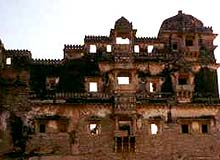In the pages of history Chittorgarh holds a proud place and regarded as the symbol of Rajput chivalry, resistance and bravery. The Chittorgarh fort is situated 175 km to the east of Udaipur and is named after Chitrangad Maurya. Chittorgarh covers an area seven mile covering 700 acres of land with its fortifications, palaces, temples and towers. The fortress of Chittorgarh epitomizes the romance and chivalry of the Rajput tradition.
The famous Chittorgarh fort is situated on a 180 m high hill that rises swiftly from the plains. The road leads through seven gates namely Padan Pol, Bhairon Pol, Hanuman Pol, Ganesh Pol, Jorla Pol, Lakshman Pol, to the main gate, Rampol. In between the second and the third gate there are two Chhatris or cenotaphs, built in honor of Jaimull and Patta, the heroes of 1568 AD siege by Emperor Akbar. The main gate of the fort is called the Surajpol (the Gate of Sun). Inside the Chittorgarh fort there are many palaces like the Rana Kumbha Palace, the Fateh Prakash Palace, the Tower of Victory and Rani Padmini's Palace. All these structures are significant for their Rajput architectural features.

The most imposing structures inside the Chittorgarh fort are the "Kirti Stambh" and the "Vijay Stambh". The "Kirti Stambh" was built by Maharana Kumbha in 1440 AD to celebrate his victory over Mohammad Khalji. The pedestal of the tower is 10 ft high and the tower stands at a height of 122 ft and is 30 ft wide at the base. The tower is nine storeyed and is adorned with sculptures of Hindu deities and stories from the Ramayana and the Mahabharata. The tower provides a breathtaking view of the city. There is a huge complex of Jain temples within the fort.
No comments:
Post a Comment